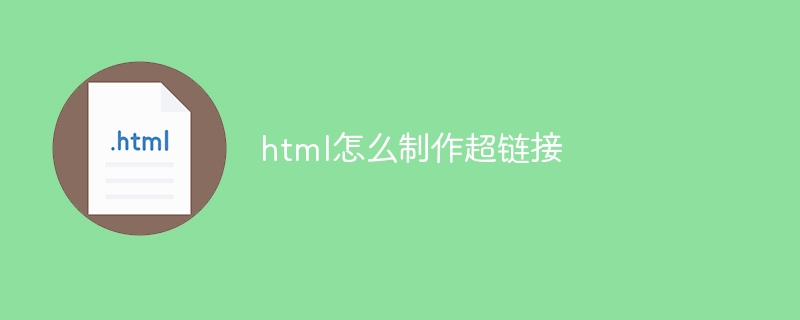How to create a hyperlink in html
Hyperlinks can be made in HTML by following these steps: Determine the URL of the target page. Create a hyperlink using the <a> tag (the href attribute specifies the link address). Write the hyperlink text inside the <a> tag. You can add title, target, and style attributes to customize the appearance and behavior of hyperlinks. Use the </a> tag to close a hyperlink.

How to create a hyperlink in HTML?
Hyperlinks are key elements in HTML that allow users to click and navigate to other pages or files. Here are the steps for creating a hyperlink:
- Determine the target page or file: Determine the address (URL) of the page or file you want to link to.
-
Writing hyperlink code: Use the
<a>tag in HTML code to create a hyperlink. Thehrefattribute of the tag specifies the target address of the link:
<a href="https://www.example.com">超链接文本</a>
- Set the hyperlink text: The hyperlink text is what the user sees on the page and click on the content. Place it inside the
<a>tag:
<a href="https://www.example.com">访问示例网站</a>
- Add optional attributes: You can add other attributes to customize the super The appearance and behavior of links, such as the
titleattribute (adds a tooltip), thetargetattribute (specifies the window in which the link opens), and thestyleattribute (sets the style ):
<a href="https://www.example.com" title="示例网站" target="_blank" style="color: blue;">访问示例网站</a>
- Close the hyperlink: Use the
</a>tag to close the hyperlink:
<a href="https://www.example.com">访问示例网站</a>
Example:
<p>我们建议访问 <a href="https://www.example.com">示例网站</a> 以获取更多信息。</p>
The above is the detailed content of How to create a hyperlink in html. For more information, please follow other related articles on the PHP Chinese website!

Hot AI Tools

Undresser.AI Undress
AI-powered app for creating realistic nude photos

AI Clothes Remover
Online AI tool for removing clothes from photos.

Undress AI Tool
Undress images for free

Clothoff.io
AI clothes remover

AI Hentai Generator
Generate AI Hentai for free.

Hot Article

Hot Tools

Notepad++7.3.1
Easy-to-use and free code editor

SublimeText3 Chinese version
Chinese version, very easy to use

Zend Studio 13.0.1
Powerful PHP integrated development environment

Dreamweaver CS6
Visual web development tools

SublimeText3 Mac version
God-level code editing software (SublimeText3)

Hot Topics
 What is the purpose of the <datalist> element?
Mar 21, 2025 pm 12:33 PM
What is the purpose of the <datalist> element?
Mar 21, 2025 pm 12:33 PM
The article discusses the HTML <datalist> element, which enhances forms by providing autocomplete suggestions, improving user experience and reducing errors.Character count: 159
 How do I use HTML5 form validation attributes to validate user input?
Mar 17, 2025 pm 12:27 PM
How do I use HTML5 form validation attributes to validate user input?
Mar 17, 2025 pm 12:27 PM
The article discusses using HTML5 form validation attributes like required, pattern, min, max, and length limits to validate user input directly in the browser.
 What is the purpose of the <progress> element?
Mar 21, 2025 pm 12:34 PM
What is the purpose of the <progress> element?
Mar 21, 2025 pm 12:34 PM
The article discusses the HTML <progress> element, its purpose, styling, and differences from the <meter> element. The main focus is on using <progress> for task completion and <meter> for stati
 What is the purpose of the <meter> element?
Mar 21, 2025 pm 12:35 PM
What is the purpose of the <meter> element?
Mar 21, 2025 pm 12:35 PM
The article discusses the HTML <meter> element, used for displaying scalar or fractional values within a range, and its common applications in web development. It differentiates <meter> from <progress> and ex
 What are the best practices for cross-browser compatibility in HTML5?
Mar 17, 2025 pm 12:20 PM
What are the best practices for cross-browser compatibility in HTML5?
Mar 17, 2025 pm 12:20 PM
Article discusses best practices for ensuring HTML5 cross-browser compatibility, focusing on feature detection, progressive enhancement, and testing methods.
 What is the purpose of the <iframe> tag? What are the security considerations when using it?
Mar 20, 2025 pm 06:05 PM
What is the purpose of the <iframe> tag? What are the security considerations when using it?
Mar 20, 2025 pm 06:05 PM
The article discusses the <iframe> tag's purpose in embedding external content into webpages, its common uses, security risks, and alternatives like object tags and APIs.
 How do I use the HTML5 <time> element to represent dates and times semantically?
Mar 12, 2025 pm 04:05 PM
How do I use the HTML5 <time> element to represent dates and times semantically?
Mar 12, 2025 pm 04:05 PM
This article explains the HTML5 <time> element for semantic date/time representation. It emphasizes the importance of the datetime attribute for machine readability (ISO 8601 format) alongside human-readable text, boosting accessibilit
 What is the viewport meta tag? Why is it important for responsive design?
Mar 20, 2025 pm 05:56 PM
What is the viewport meta tag? Why is it important for responsive design?
Mar 20, 2025 pm 05:56 PM
The article discusses the viewport meta tag, essential for responsive web design on mobile devices. It explains how proper use ensures optimal content scaling and user interaction, while misuse can lead to design and accessibility issues.






